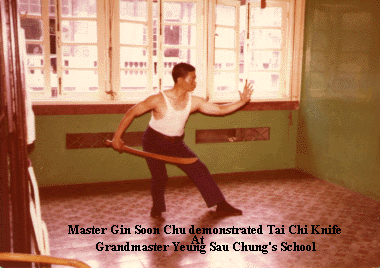 Tai Chi Broadsword
is one of the short weapons in the Tai Chi Chuan system. It shares the same
concepts and principles as Tai Chi Chuan in practice. Tai Chi Chuan practice
emphasizes the concepts of: Tai Chi Broadsword
is one of the short weapons in the Tai Chi Chuan system. It shares the same
concepts and principles as Tai Chi Chuan in practice. Tai Chi Chuan practice
emphasizes the concepts of:
* slowness
* lightness
* relaxation
* calm
* the use of intent and not physical force
* the sinking of chi down to dantien
* suspend the head from above
* concentration
* the harmonization of the internal and external
* coordination of the top and bottom.
The same concepts are emphasized in the practice of Tai Chi's Broadsword
as well.
Tai Chi Broadsword expresses its characteristics as a broadsword as well.
Therefore, when one is practicing the broadsword, one should be aware of the
back of the broadsword, so as to use it to block to get closer to the opponent.
A quicker speed and a powerful chop are additional characteristics. In practice,
one must demonstrate the 13 techniques (upper cut, under cut, cross cut, chop,
split, lift, stab, block, pull coiling, push, intercept and parry). One must
understand the application in each movement so as to properly execute the
movements. Proper practice must demonstrate each movement's intention,
application and correct position with speed and power.
One of the requirements for the correct practice of the Tai Chi Broadsword is
that the broadsword and the hands must be coordinated and move in unison in each
movement. In the form, the right hand often holds the broadsword and the left
hand forms a palm strike or block. It is common knowledge among martial arts
practitioners that the coordination between the hands and broadsword are
important. It is commonly said that when one is practicing the single
broadsword, the spectator generally looks at the practitioner's hands and when
one is practicing the double broadsword, the spectator should look at the elbows
to determine the skill of the practitioner. In the Tai Chi Broadsword form, the
left hand's movement is often towards the top of the head to block, or with bent
wrist for balance, and many times the palm, arm and elbow are used to strike.
Another requirement for proper practice of the Tai Chi Broadsword is that the
body must be coordinated with the broadsword at all times. This means that in
addition to the hands, the four limbs, shoulders, elbows, hips, knees, feet,
back, chest, head and eyes should guide, and be coordinated with the
broadsword's movements. In some movements, it is necessary to move the feet to
compensate for the broadsword's techniques. All movements are initiated by the
waist. When one part of the body moves, all move. There is an emphasis on
utilizing the whole body to support the broadsword's movements. Therefore, when
the broadsword and the body are coordinated, the movement is correctly executed.
If the body and the movements of the broadsword are not coordinated, the
shoulders, elbows and wrists will be stiff. One will not be able to utilize the
broadsword's profound techniques. Therefore, it is recommended that one should
master the Tai Chi Chuan's Solo Form and all the fundamentals prior to engaging
in broadsword training.
The next requirement in proper practice of the Tai Chi Broadsword is that
offensive and defensive moves are combined together into one movement. Together
means that within each movement, there are both offensive and defensive moves.
In practice, one must know what is meant by offensive and defensive moves.
Therefore, one must understand each movement's hard and soft components. "Hard
components" refers to offensive moves and "soft components" refers to defensive
moves. Therefore, in order to clearly demonstrate the hard and soft components
within each movement, one must understand their intention and application.
|



